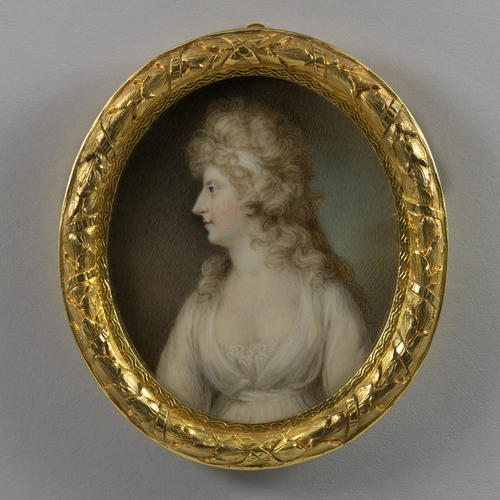-
1 of 253523 objects
Queen Caroline (1768-1821), when Princess of Wales Signed and dated 1795
Watercolour on ivory | 7.5 x 6.4 cm (sight) (sight) | RCIN 420194
-
This miniature was painted in the year of Caroline's marriage to the Prince of Wales, later George IV.
Caroline (1768-1821) was the second daughter of Karl II, Duke of Brunswick-Wolfenbüttel, and Princess Augusta, sister of George III. At the age of 14 she was described as 'a lively, pretty child with light-coloured hair hanging in curls on her neck, with rosebud lips … and always simply and modestly dressed'. Her marriage was arranged to George, Prince of Wales. George had secretly, and illegally, married Maria Fitzherbert in 1785 but he was forced to marry legitimately in order to produce an heir to the throne. Their only child was Princess Charlotte Augusta (1796–1817). Three days after his wife's confinement, the Prince wrote a will in which he declared that Maria Fitzherbert was his only true wife, and that 'to her who is call'd the Princess of Wales' he left one shilling. The inevitable separation took place in 1796. During the Regency, Caroline was excluded from the court and only with difficulty could she obtain permission to see Charlotte. She decided to leave England, and set off on a series of travels around Europe. Evidence of her indiscretions was collected or concocted and her husband asked Parliament to strip Caroline of her title and to end their marriage by Act of Parliament, but the bill was not passed Less than a fortnight after her husband's coronation, the Queen was taken ill at the theatre and, after a short illness, died.
Philip Jean (1755-1802) was born in St Ouen, Jersey. He served in the navy under Admiral Lord Rodney and later became a professional miniature painter. He exhibited at the Royal Academy from 1787 to 1802, including miniatures of the Duke of Clarence (1790), the Duke and Duchess of Gloucester (1790 and 1792), Princess Sophia Matilda of Gloucester (1791 and 1795) and Prince William of Gloucester (1792 and 1802). He also painted full-length portraits of George III and Queen Charlotte. In 1788, one Royal Academy critic described him as an 'ingenious foreigner'.
Signed and dated on the backing paper in ink: Ph: Jean / pinxt / 1795 / London.Provenance
Commissioned by George IV when Prince of Wales
-
Creator(s)
Acquirer(s)
-
Medium and techniques
Watercolour on ivory
Measurements
7.5 x 6.4 cm (sight) (sight)
9.6 x 8.4 cm (frame, external)
Category
Object type(s)
Other number(s)
RL 1870 6.B.1
